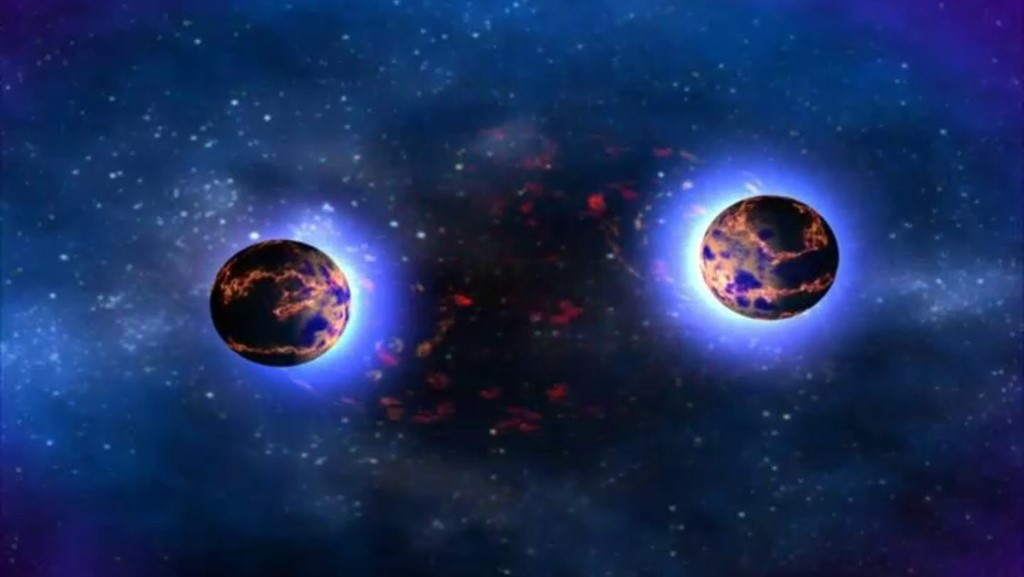Researchers have found a new way to detect some of the most cataclysmic mergers in the universe before they happen. Neutron stars , the extremely dense cores of massive dead stars, spiraling toward each other or into a black hole can raise tidal waves in the oceans of heavy charged particles surrounding the neutron stars. Those tidal waves reveal themselves through regular flashes of electromagnetic radiation, which can serve as an early warning system for impending mergers, the researchers found.
Neutron stars are arguably the most extreme objects in the universe. Yes, black holes may be more exotic, but they’re relatively simple — they’re just lots and lots of gravity . In contrast, neutron stars are essentially gigantic atomic nuclei, and that comes with a lot of interesting, complex physics that black holes don’t get to share.
Related: Scientists catch 1st glimpse of a black hole swallowing a neutron star A typical neutron star is only a few kilometers across yet can weigh up to a few times the mass of the sun . They are made almost entirely of neutrons (hence the name) but do contain populations of loose electrons, protons and ions of heavy nuclei. They are born from supernovas — explosions of dying massive stars — and some can host the strongest magnetic fields in the entire universe.
The interiors of neutron stars are the most mysterious, since the pressures and densities are so extreme that they go beyond our current knowledge of physics. Some models suggest that the cores are simply a homogenous blob of neutrons, while others hint that the neutrons themselves break down into their component quarks. Beyond the inner core lies a solid, smooth bulk of neutrons that slowly transitions into more complex patterns, such as lumps and strands, collectively known as nuclear pasta .
The outer crust of a neutron star is thought to consist of superfluid electrons and neutrons giving way to a crystal lattice the closer you get to the surface. Finally, there’s an ocean — a layer of liquid electrons, neutrons and ions anywhere from 10 to 100 meters (33 to 330 feet) deep. The extremely exotic nature of matter in these conditions — you don’t typically find superfluid neutrons just lying around — enables neutron stars to be a prime candidate for studying extreme physics.
This idea has been enhanced since the discovery of GW 170817, a gravitational wave signal detected alongside the electromagnetic emission of two merging neutron stars. The joint detection, dubbed multimessenger astronomy, allows physicists to probe the hearts of neutron stars like never before. But since that first gravitational wave detection in 2017, we haven’t seen any other neutron star merger events — which is frustrating, because neutron stars are among nature’s best laboratories for testing high-energy physics.
But now, a new method for observing the exotic behavior of neutron stars may mean we don’t have to wait much longer. The new work, published in May in the preprint database arXiv , focuses on the neutron star oceans, which, besides free electrons and neutrons, can also contain carbon, oxygen and iron. Although the oceans are relatively shallow compared with the entire depth of the neutron star, they are the outermost layer (not including an incredibly thin “atmosphere”) and the part of the neutron star that most readily reacts to the outside universe.
In particular, the researchers found that these shallow oceans can support tides, just as oceans do on Earth . But raising a tide on a neutron star requires a lot more gravitational pull to overcome all that extreme gravity. Tides on neutron stars appear only when the neutron star is close enough to a massive, dense object, like another neutron star or a black hole.
Thankfully, these kinds of binary pairs are relatively common, as stars tend to form in multiple systems and then go on through their life cycles, eventually leaving behind combinations of black holes and neutron stars. When a neutron star begins to merge with another neutron star or a black hole, the objects spend a few years slowly spiraling in toward each other. As they orbit, gravitational waves carry energy away from the system, pulling the couple closer.
Eventually, in the final moments, the merger is over in a matter of seconds. But before that happens, the orbiting companion can raise a series of resonant tides on the neutron star. Those tides can maintain frequencies of up to 100 megahertz and carry up to a whopping 10^29 joules of energy.
To give you a sense of just how awesome that number is, every year all of humanity uses a mere 10^20 joules. A single neutron star resonant tidal wave has more energy than the entire output of the sun shining for 10,000 years. Unlike ocean waves, these tides are made of an ocean of plasma.
The extreme electric charges mean that as the tides slosh around, they can emit intense bursts of electromagnetic radiation , which can appear to us as flashes of X-rays and gamma-rays. — A neutron-star crash spotted 3 years ago is still pumping out X-rays. But why? — Possible massive ‘kilonova’ explosion creates an epic afterglow — Neutron stars release warm winds as they devour companion stars Based on their calculations, the researchers estimate that space-based observatories, like the Fermi Gamma-ray Space Telescope and the Nuclear Spectroscopic Telescope Array (NuSTAR), can detect a handful of neutron star inspirals every year and that these signals will appear up to a few years before the final merger.
With that kind of warning, astronomers can prepare their telescopes and observatories so they’re ready to catch the moment of the merger itself and dig into even more precious electromagnetic and gravitational wave data. Follow us on Twitter @Spacedotcom or on Facebook . .
From: space
URL: https://www.space.com/neutron-star-mergers-tidal-waves/
